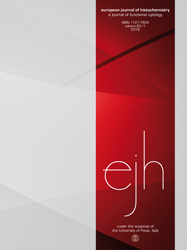0
0
0
0
 Smart Citations
Smart Citations0
0
0
0
Citing PublicationsSupportingMentioningContrasting
See how this article has been cited at scite.ai
scite shows how a scientific paper has been cited by providing the context of the citation, a classification describing whether it supports, mentions, or contrasts the cited claim, and a label indicating in which section the citation was made.
ECRG4 expression in normal rat tissues: expression study and literature review
Altmetrics
Downloads
Supporting Agencies
Ministry of Science and Education, Poland (grant IP2011 046671).How to Cite
ECRG4 expression in normal rat tissues: expression study and literature review. (2015). European Journal of Histochemistry, 59(2). https://doi.org/10.4081/ejh.2015.2458
PAGEPress has chosen to apply the Creative Commons Attribution NonCommercial 4.0 International License (CC BY-NC 4.0) to all manuscripts to be published.








